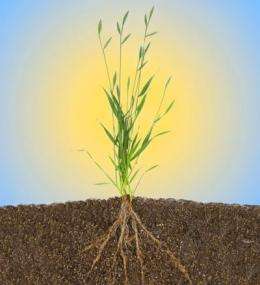Scientists sequence genome of grass that can be a biofuel model crop

U.S. Department of Agriculture (USDA) scientists and their colleagues at the Department of Energy Joint Genome Institute today announced that they have completed sequencing the genome of a kind of wild grass that will enable researchers to shed light on the genetics behind hardier varieties of wheat and improved varieties of biofuel crops. The research is published today in the journal Nature.
"Energy security looms as one of the most important scientific challenges of this century," said Molly Jahn, USDA Acting Under Secretary for Research, Education and Economics. "This important research will help scientists develop switchgrass varieties that are more suitable for bioenergy production by identifying the genetic basis for traits such as disease resistance, drought tolerance and the composition of cells."
The grass, Brachypodium distachyon, can be used by plant scientists the way other researchers use lab mice to study human disease - as a model organism that is similar to but easier to grow and study than important agricultural crops, including wheat and barley. The research also supports the USDA priority of developing new sources of bioenergy; the brachypodium genome is similar to that of the potential bioenergy crop switchgrass. But the smaller genome of brachypodium makes it easier to find genes linked to specific traits, such as stem size and disease resistance.
Brachypodium (pronounced bracky-POE-dee-umm) also is easier to grow than many grasses, takes up less laboratory space, and offers easy transformation, which means scientists can insert foreign DNA into it to study gene function and targeted approaches for crop improvement in the transformed plants, said John Vogel, a lead author and molecular biologist with the Agricultural Research Service (ARS), USDA's chief intramural scientific research agency. Vogel works at the ARS Genomics and Gene Discovery Research Unit in Albany, Calif. ARS geneticist David Garvin at the agency's Plant Science Research Unit in St. Paul, Minn., is also a lead author on the paper.
A major stumbling block in using switchgrass or any perennial grass as a biofuel crop is the difficulty in breaking down its cell walls, an essential step in producing ethanol from cellulosic biomass. Brachypodium may hold the key to finding ways to produce plant cell walls that are easy to break down, Vogel said.
Vogel developed a method with a very high success rate for inserting genes into brachypodium. He, Garvin and their colleagues are spearheading efforts to promote brachypodium as an experimental model. They shared brachypodium seeds with more than 300 labs in 25 countries and gave scientists worldwide free access to a draft sequence of the brachypodium genome long before the work was formally published. The sequencing project was carried out through the DOE-JGI Community Sequencing Program.
More information: ‘Genome sequencing and analysis of the model grass Brachypodium distachyon’ will be published by Nature on 11th February 2010 Vol 463 11 February 2010. doi:10.1038/nature08747
Provided by United States Department of Agriculture



















